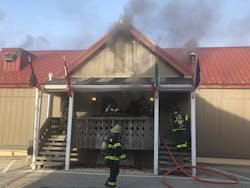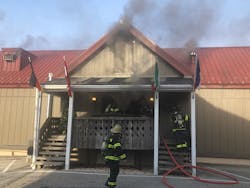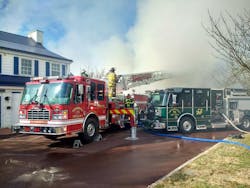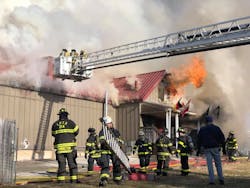Last month, we detailed a terrifying incident involving a captain becoming lost inside a complex structure in Montgomery County, PA. Lower Providence Fire Department Captain Alex Davis had been exiting the structure with his crew when he became separated and suddenly didn’t know which direction was out. Davis shared his story, and we also heard from Battalion Chief Christopher J. Reynolds, who managed the mayday event.
In this article, we’ll review accounts from Chief James Alexander, who served as the IC on the incident, and Lt. Mike Rohlfing, the Squad 53 officer who helped locate Davis, and I’ll provide some key points of consideration based on my discussions with Davis, Alexander and others.
Account from Chief James H. Alexander III, the IC
That Saturday morning, I was at Giant grocery store picking up some groceries. My pager went off for a building fire at Salter’s Ski Shop, so I immediately left the store and responded with county dispatch. They gave me the details of reported heavy smoke condition inside with no visible fire, so I had them upgrade the alarm to the working fire dispatch.
When I arrived on scene, I got my gear on and Engine 53 was already establishing a water supply and pulling a preconnect. Quint 53 arrived and assisted the engine company with forcible entry.
I started conducting my 360 of the building on Side B. I had smoke from the eaves, and there was a small square opening that had visible fire showing. Side A was the same, Side C was an attached exposure that was not affected, and Side D showed heavier smoke from the eaves. Quint 46 was on Side D with its aerial main to the roof. I had Squad 53 pick up the hydrant behind the firehouse and lay a supply line to Side D.
I met up with Battalion Chief Reynolds at the duty chief vehicle and established the Command Post. At that point, all companies were working, and I requested the second alarm to be transmitted. We then started getting reports about how conditions where changing on Side B, and I told the hose team to back out.While backing out, one of the firefighters, Davis, became separated from the crew. Once this was discovered, it was radioed to command that there was a firefighter unaccounted for. It was at this time that Captain Davis declared a mayday. I then declared the mayday with county, which brings a Mayday Task Force. This consists of one engine, one ladder, one rescue and two ALS ambulances. In these situations, county protocol includes toning out mayday on all channels in use, moving all non-mayday traffic to a new channel (above and beyond any others in use) and alerting the Mayday Task Force units. If the dispatcher is unable to reach the IC following a mayday, they have the ability, in their discretion, to alert an additional alarm above and beyond everything on scene and requested by the IC.
We closed the command vehicle and Reynolds stayed on talk group “Event 4” and talked to Davis until he was found.
Meanwhile, the rapid-intervention team (RIT) arrived, and I had a face-to-face with their deputy chief. They went to Side B to focus on rescue. When they got over there, Rohlfing had just located Davis and helped him to the outside. The mayday was cleared, and Davis went to get checked out by EMS, and then reported to the Command Post. I gave him a hug and we talked for a minute. He then reported back to his company and went back to work.
At that point, I ordered defensive operations and we established a collapse zone. We repositioned the apparatus outside the collapse zone and went to ladder pipe operations.Account from Lt. Mike Rohlfing, who located Davis
The biggest take away from this fire, as it relates to my actions, is that I should have deployed a search rope or webbing at the door prior to making entry after the mayday was declared. I heard the mayday being toned out and asked someone who it was for, so I knew who to look for. Once I knew who I was looking for, I just went inside. I never thought about how the inside conditions might be deteriorating, and perhaps I should have grabbed a line. I never asked if anyone else was inside looking for him. I should have, as maybe they went right, and I should go left, etc.
I decided as I was masking up to go in for him that this was going to be my final stand: I was either going to find him or die trying. I'm not proud of that thought, but I keep coming back to it. Is it reckless bravado? Should I be that willing to die? Was it the right mindset before entering a fire?
I paused a few feet in the door to listen to Battalion 53 talking to Davis so I could try to decide which direction I should go. I heard banging around inside and decided to go straight in, as I couldn't tell which way he initially went from the radio transmissions (or perhaps I didn't hear) and figured there wouldn't be merchandise directly in the door. I tried calling him to ask if he was in fact making the noise because I heard him asking for people to bang on the walls. In hindsight, I should have called him again after he didn’t answer me.
I didn’t hear him calling the mayday, just the county tone out of the mayday emergency. That taught me that should I ever need to call a mayday, I’m going to loudly say “mayday, mayday, mayday” before saying anything else. I don’t think anything would have changed that much had I heard his mayday before the tone out, but maybe someone at the door may have gone in.Comments by Chief Goldfeder in discussion with Davis and Alexander
The following are key points about this incident based on notes from Davis and Alexander. The comments in italics are my thoughts and suggestions related to each point.
Davis: I was confident, originally, that I would find my own way out, which caused me to delay declaring the mayday. In hindsight, had I gotten on the radio and asked for the E53/QT53 crew to hold up, or to backtrack and find me, this likely would have been no event at all. One lesson learned was not to assume that I will find someone if I become separated in conditions like that.
Goldfeder: Never assume that you will find your way out. And never assume you aren't having a mayday. If you are thinking you have a problem, start telling command about it now. If you make it out, great! If you are still jammed up, you have provided command with info so the mayday policy can be enacted.
Davis: The heat in the building after the mayday was concerning, but never rose to a consistent level of discomfort. The fire was actually believed to be burning in a 2–3-foot void space between the ceiling of the fireplace store and the floor of the ski shop. This void space was believed to have been created when the second story of the building was added some 15–20 years after the lowest level was built. As such, the heat in the building was concentrated in various pockets.
Goldfeder: This point drives home the fact that the mayday is a second incident requiring its own resources. The fire—the original reason you responded and why you now have a mayday—must continue to be a priority.
Davis: I knew I needed noise to orient myself, which is why I asked them to bang. In hindsight, water is very loud and typically readily available at fire scenes. Having someone flow a hoseline at the ceiling right inside the door would have likely immediately caught my attention. Additionally, given that I was free-moving and not pinned to the floor or otherwise concerned with the quantity of water in there, flowing water in this compartment would have provided cooling, which was one of my two primary concerns (the other being air supply).
Goldfeder: Whatever is decided upon, everyone should be aware of the plan. If everyone flows water and everyone else bangs walls, it may be counterproductive. The fact that the ONE chief was assigned to the mayday was outstanding, allowed the other chief to keep working the fire.
Davis: After calling the mayday I activated my PASS alarm, but never stopped to turn it off to listen for banging. Instead, I attempted to listen through it. I’m not sure if that made a difference or not, but in hindsight, it may have been wise to shut it off intermittently to listen for the sound I was hoping to hear.
Also, I never got all the way down on my stomach with my face on the ground looking for that theoretically present inch of clear air. My perception as I crawled was that the smoke was to the floor, but I never actually checked. I would suggest a firefighter in a similar situation check that in hopes to orient him or herself.
Goldfeder: Drilling and more drilling with all mutual-aid partners using the same policies helps determine what may work best. Without policy and few drills, problems are predictable—problems on what may be the worst day of our career.
Davis: Remaining calm during a mayday event relates to all sides, from the mayday firefighter to the chief working the mayday to the crews attempting rescue is paramount. The chief working this mayday called me by name in textbook fashion and it was a calming factor.
Goldfeder: That "personal" connection worked well. Be it a close friend or a mutual-aid or covering chief, communication is critical for success when the mayday occurs. And in order to have good communication, we must drill with those who will be there when that fire and mayday occur.
Davis: My department is pretty proactive about training and creating a culture and an environment that promotes learning. When I was lost in the ski shop, I started thinking about who I knew was on scene, and I had very high confidence that we had the training and experience on scene needed to resolve the issue. I’ve been at other departments and other scenes where I’m not so confident I would have had that feeling.
Goldfeder: I appreciate the honesty and for saying what many feel. The solution is to collaboratively work with all area departments, develop understandable and best practices-based policy—and then drill on it. And drill on it again. And again. It never ends! It's 2019, and there is nothing wrong or insulting about expecting any responding company to have well-trained, qualified and disciplined firefighters arriving ready to go to work based on agreed upon operational policy, guidelines and procedures.
Davis: I elected to lead from in front of the hose crew for both optical and tactical purposes. Consideration should be given in large commercial occupancies to leading behind the nozzleman instead of in front.
Goldfeder: In my company officer days, I was always a fan of putting my least experienced (qualified/trained) firefighter on the knob and then being there with that firefighter, guiding and supervising, with my other members backing up. I did that because everyone wants to be on the knob and that can greatly lessen experience for the new kids. Whatever your preference is, make sure everyone knows where everyone is on that line or the crew.
Davis: Crew integrity and communication is paramount. I failed to contact them via radio as soon as I realized I was separated so the crew failed to realize that I was not following along.
Goldfeder: As mentioned above, the moment you think you're in trouble, start following your training, which should start with a radio transmission.
Davis: Take information provided by bystanders at face value. I assumed the location of the stairwell provided to me came from an employee. I was mistaken, and so was the bystander. There was no stairwell in the area we were told there was
Goldfeder: Their information is helpful, but we need to determine the facts ourselves, and preferably that starts with a preplan well before the fire.
Davis: Company officers taking initial action must communicate knowledge and planned actions with the IC. This can typically take place via face-to-face interaction, but on large commercial occupancies, care and time must be taken to communicate this over the radio.
Goldfeder: One of the most important things to remember is that while we may go to dwelling fires 99 percent of the time, this is not a dwelling fire, and our tactics are different. In every case, regardless of the occupancy, an initial-arrival report with standard information, including your incident action plan (IAP), is mandatory. For example: “Engine 5 is on the scene with a large strip mall with a working fire with smoke showing on the A/B corner. Engine 5 has a hydrant and we are stretching a 2-inch attack line to the alpha side for fire attack. Engine 5's officer has tactical command and we are in the offensive mode. Dispatch strike the second alarm.” If you consider this report and fill in the blanks based upon the structure, it will become habit, and then the plan, the fire conditions and resources needed will always be part of the initial size-up report.
Alexander: Clarify the identification of each floor level. Command must profoundly announce the identification of each building level (e.g., Division 1, 2, 3 roof, basement). On this particular job, Division 1 on Side D was one level below what appeared to be Division 1 on Side B.
Goldfeder: An excellent point. The initial and ongoing size-up must include this relevant information so everyone on the fireground is following the same plan. When in doubt, ask!
Alexander: With the understanding that it is dependent upon available qualified personnel, Command must make division and group leaders clear from the onset visibly supported at the Command Post. Though the roles were in fact filled, it was happening so fast that command couldn't keep up.
Goldfeder: In addition to constant drilling with all applicable companies, practicing these aspects of command, even on what may be minor incidents, keeps our skills sharp for when we need them most. Treat fire alarm responses, carbon monoxide (CO) alarms and other runs as an opportunity to never stop practicing the “standard” reports and related skills.
Alexander: Reinforce the benefits of maintaining situational awareness. Leaders at both company and division supervisory level(s) recognized the rapidly changing conditions and assertively initiated steps to maintain the safety of the personnel.
Goldfeder: It is policy/procedural-based training that takes us from being unfocused spectators wearing bunker gear to becoming focused, effective and disciplined firefighters.
Alexander: Provide additional updates to group and division supervisors throughout incident on the IAP so personnel are informed
Goldfeder: I have become a HUGE fan of Conditions-Actions-Needs (CAN) reports. That pretty much showcases what is required when communicating on the fireground: What are the conditions? What are you doing (your actions)? What do you need? It beats the daylights out of everyone deciding what they should (or would like) to say when transmitting and giving progress reports. CAN gets right to the point without a whole lot of chatter.
Additional notes
Following are some general thoughts not specific to this fire but useful for similar incidents.
First-alarm assignments
Once again, we see a department, in this case a volunteer department, absolutely “getting it" as far as the need for a heavy first alarm. What’s a “heavy” or an adequate first alarm? Calculate it based upon the needed fire flow, the building, access, goals and required tasks. For example:
· Water supply—hydrant and pump operators
· Access—how can you get into the building?
· Size-up—include a 360 when physically possible
· Handlines/fire attack—three firefighters including an officer per line
· Search per floor—two firefighters
· Rescue—many firefighters
· Truck work—at least two per floor
· Ventilation/smoke management—as assigned
· Firefighter rescue—if a member is trapped, this can be in excess of 10–20 firefighters, but at a minimum, rapid intervention needs enough members to search/locate, then a crew to secure/administer medical aid, and then another crew to remove the member
· Command staffing—at minimum two command-level officers (one IC and one division), but that is extremely minimal. Consider 3 to 5 and place chiefs in command, command aide, division supervisors, division safety positions
· EMS
All should be alerted at the same time so that all or most arrive simultaneously to conduct the required and ordered tasks.
Seem like a lot? It won't be if you need them, and when you need them, you need them NOW. Don't have the staffing at your department? Piece of cake: Start working and training with your neighbors.
Finding a missing firefighter
From radios to PASS alarms to using a search rope or following a line, the goal is to get them out. The answer is to drill regularly based upon best national practices with your first- and second-alarm companies. Develop some policies and then drill, drill and drill. You will then figure out what will work best in your environment when a mayday is quickly transmitted.
During the mayday
Remember that the mayday must be led and coordinated, but the fire, which is what caused all this, must still be found, knocked down and the smoke removed or at least isolated. If your department does not have a first-alarm assignment or a rapid second that can address BOTH tasks, then it's time to fix that.
Alarm assignments in areas using mutual aid
The goal of alarm assignments is to get plenty of well-trained firefighters on a scene quickly, led by good bosses. That's it. So many areas continue to use what I call “personality-based mutual aid,” picking and choosing who they like for their assignments and avoiding those who they don’t like. We still see towns driving through 2–3 or even more jurisdictions away because the chief likes this department but doesn't like that department.
Don’t like someone or some neighboring department? NO ONE CARES! Really. Liking them is irrelevant. What people, including your own firefighters, do care about is that the closest, fastest and most appropriate mutual-aid resources be called. It is that simple.
Commercial fires
The commercial fire is the uncommon fire for almost all of us. Add a mayday factor and we as firefighters and officers have arrived at what can be referred to as a “final exam” or “Super Bowl,” when everything we have learned gets applied in the most stressful of conditions. Emotions can kick in hard, especially since these are our brothers and sisters. It’s a big deal.
As the officer of the squad very honestly shared with us: “Once I knew who I was looking for, I just went inside. I never thought about how the inside conditions might be deteriorating and perhaps I should have grabbed a line. I never asked if anyone else was inside looking for him. I should have, as maybe they went right, and I should go left.”
All he wanted to do is get his brother out—and I totally get that. The goal, however, includes not just finding his brother firefighter and getting him out but also not creating a situation where the officer going in becomes another part of the mayday.
As we’ve seen from our brothers and sisters in Lower Providence, these fires create significant challenges that require well-trained, disciplined firefighters and command officers. Many close calls and worse have been due to some departments using single-family dwelling tactics in a commercial—or larger—building. The only way to overcome that is training.
The fact is that standard operational procedures (SOPs) that are aggressively trained upon by disciplined firefighters, under strong and competent commanders, can help ensure a much better chance of taking care of the fire—and ourselves.
In this case, so much of what the Lower Providence firefighters, their leadership and their mutual-aid companies did was exactly what had to be done, leading to a very positive outcome. That doesn't happen by accident.
Our sincere thanks to all those companies, departments, firefighters, EMTs, police and fire dispatchers involved with this fire.
To read Part 1, click here.
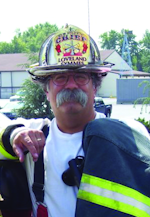
Billy Goldfeder
BILLY GOLDFEDER, EFO, who is a Firehouse contributing editor, has been a firefighter since 1973 and a chief officer since 1982. He is deputy fire chief of the Loveland-Symmes Fire Department in Ohio, which is an ISO Class 1, CPSE and CAAS-accredited department. Goldfeder has served on numerous NFPA and International Association of Fire Chiefs (IAFC) committees. He is on the board of directors of the IAFC Safety, Health and Survival Section and the National Fallen Firefighters Foundation.
